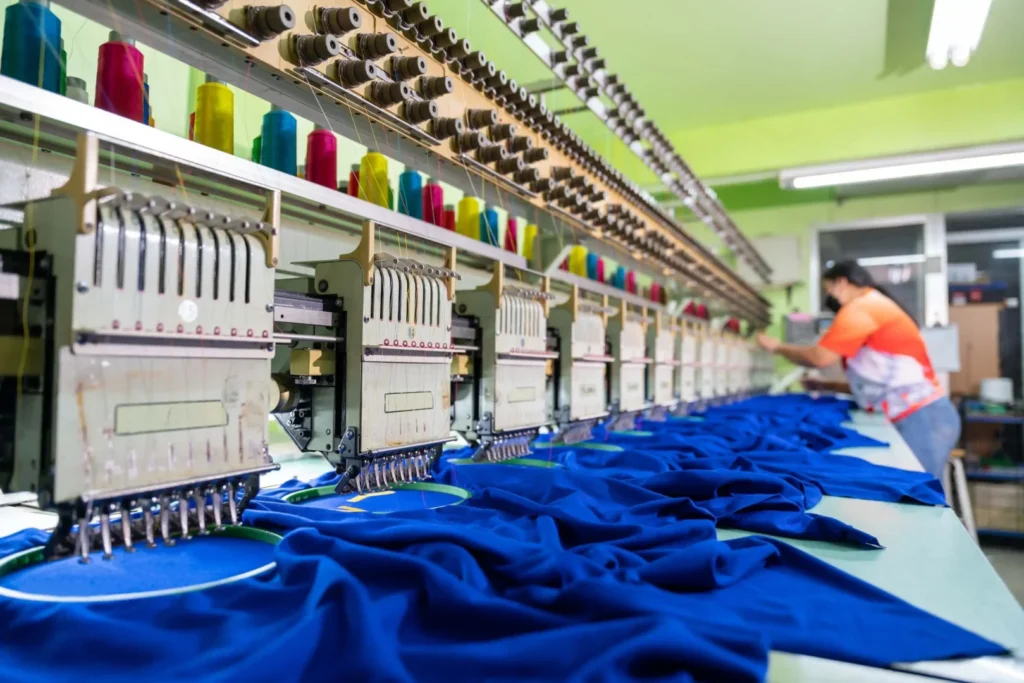Summary
- The use of clothing manufacturing equipment offers several competitive advantages for businesses
- When choosing which one to invest in, there are some crucial points to consider
- Experience a new way of creating and producing with the Audaces360 multisolution!
It is already clear that clothing manufacturing equipment is an indispensable ally in all companies. Equipping oneself with this type of technology can significantly improve efficiency and results while avoiding errors and the need for rework.
Choosing a machine requires various evaluations, as it is a strategic and often expensive investment.
In this article, we have gathered some aspects for you to consider when making your decision. If you are considering purchasing a clothing production machine, keep reading.
Enjoy your reading!
Sumário
Why choose the right equipment for your manufacturing?
Clothing manufacturing equipment makes all the difference in the fashion industry. Its use brings various organizational and competitive advantages to companies in the sector.
Here are some reasons to choose them:
Precision
Clothing manufacturing equipment allows for precise and consistent production of fabrics and clothing pieces. They offer many cutting and sewing possibilities and can handle different types of fabrics, including delicate materials such as silk and lace.
With textile machines, designers can create complex designs, achieve perfect seams, and improve the overall quality of their products, even when producing in large quantities.
Time and material savings
Clothing machinery helps reduce production time and costs because it can cut and sew in a much faster continuous cycle than manual processes.
The use of cutting machines and advanced marker-making software also helps to reduce material waste. For example, cutting with zero space between patterns or automatically running optimized fitting allows the best use of the fabric.
Team communication
One of the biggest challenges faced by those involved in clothing production is effective communication between teams. Frequently, crucial information is lost, not standardized, or it is unclear at which stage the collection pieces are.
Fortunately, some technologies can monitor and share process management in real-time. This greatly simplifies communication and collaboration among teams!
An example is Fashion PLM, management software developed precisely to improve the collection development process.
Even top-of-the-range machines are designed to collect data and provide accurate reports that facilitate decision-making and process analysis.
Efficiency
Clothing machinery enhances efficiency in the fashion industry by enabling faster and more precise production processes.
By utilizing advanced machinery and automation, clothing manufacturers can produce garments with greater precision and efficiency. Moreover, technology has revolutionized how fashion brands design and market their products.
Using digital design software (CAD), designers can create complex and detailed patterns, while social media platforms provide brands with a direct channel to connect with customers and obtain feedback.
Learn more: Why invest in a good fabric cutting table for garment production?

What are the most commonly used machines in industrial manufacturing?
The right clothing manufacturing equipment can make all the difference in clothing production. Here are the main and most popular ones in the industry:
Sewing machine
When thinking about clothing production work, the first machine that comes to mind is the sewing machine. There are several types, but these are the most common:
- Linear sewing machine, designed for straight stitches and can be adjusted for different fabrics
- An industrial overlock machine, which can also use 3, 4, and 5 lines, designed to sew and finish the edge at the same time
- Industrial buttonhole machines, specific machines for making buttonholes
Cutting machine
Among the clothing manufacturing equipment, the cutting machine is essential. This machinery is an essential support for clothing manufacturers who need to produce large quantities of clothing industrially.
It allows various layers of fabric to be cut with maximum precision, increasing efficiency and reducing errors and rework.
A cutting machine like the Audaces Neocut Bravo also has the great advantage of continuously monitoring working conditions for quick problem resolution.
And that’s not all: it also produces production progress reports for effective decision-making.
Learn more: Learn why regular maintenance is crucial for fabric cutting machines
Spreader
Another common equipment in clothing production is the spreader. Its purpose is to automatically fold and overlap the fabric in multiple layers, thereby preparing it for the cutting process.
A spreader like the Audaces Linea allows several spreads to be programmed on the same day, ensuring the highest quality.
A much faster and more efficient process than manually spreading the fabric!
Learn more: Discover what automatic fabric spreading is and how to make it properly
How to choose which equipment to buy?

After realizing the importance of investing in clothing manufacturing equipment, you may wonder how to choose yours.
With so many options on the market, we advise you to pay attention to three aspects:
Request a demonstration
Seeing the machine firsthand is essential for making an informed choice.
We recommend that you see the machine you intend to buy in person, regardless of the type of machine.
Whether at a trade show, by visiting the supplier’s showroom, or by a customer who is already using the machine.
Before the demonstration, list the questions you would like answers to: consumption, difficulty of use, fabrics they can use, service, etc.
During the demonstration, observe the machine’s operation closely and take the opportunity to ask other questions.
Evaluate payment conditions
The investment required for the purchase of clothing machinery is usually significant. Therefore, we recommend that you pay close attention to payment conditions.
These conditions are usually explained in the sales contract, which should be dealt with carefully and kept.
Consider if the price includes transportation, delivery, assembly, commissioning, and testing or if these costs are additional.
Prioritize responsible brands
The reputation and history of the brand are other factors that can help you choose the right clothing machinery for your needs.
Identify reliable suppliers with many years of experience in the market that can give you confidence. The level of support that a company provides, both before and after purchase, is a clear indication of its strength.
If you don’t know where to start, it can be helpful to consult industry blogs, where you can seek guidance from other professionals.
Learn more: How to obtain quality and precision in the cutting fabric process?
Where can I buy clothing manufacturing equipment?

Audaces has been a market leader, developing and producing machines and software for the fashion industry for over thirty years.
Audaces Cutting Room
If you want to equip yourself with the best technology and have control over all processes, the Audaces Cutting Room is for you.
The Audaces Neocut Bravo integrated with the Audaces Linea spreader is an essential solution for an automated cutting room and stands out in the market for the flawless cutting of multiple layers of fabric or flexible materials, with zero spacing between the patterns.
Neocut has an intelligent CAM point that selects the blade entry point, maintaining pattern integrity while optimizing productivity and speed.
The cutting head technology represents excellence in the sector, with a blade deflection system and more than 300 sensors to control and monitor the production process.
If you want to explore the positive impact that the Audaces cutting room would have on your company, sign up for our free automation project:
FAQ
Choosing the right machinery for the clothing sector provides greater precision, time and material savings, better team communication, and efficiency.
Sewing machine, cutting machine, and spreader.
Request a demonstration, evaluate payment conditions, and prioritize reliable brands.










